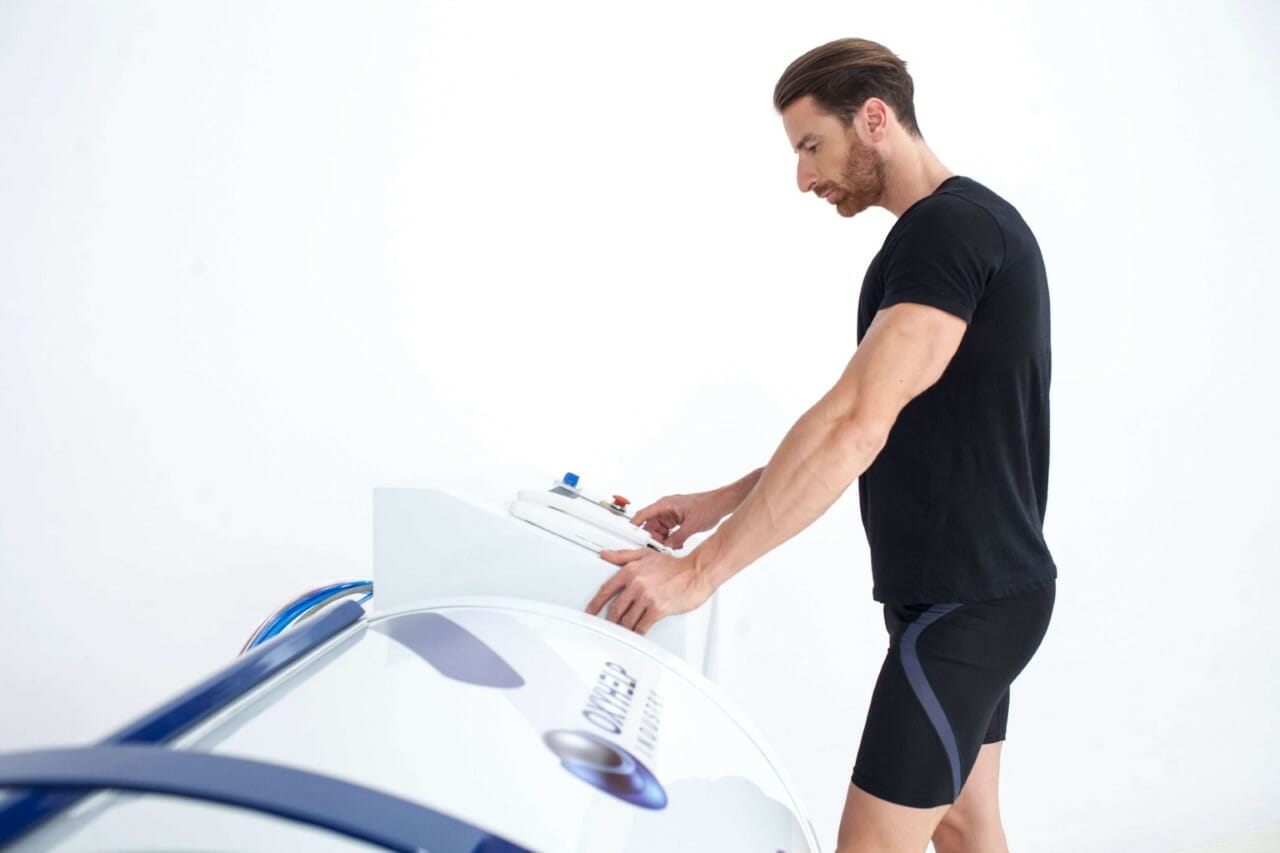The process of breathing is based on a complex system, supported by the muscles of the upper body. When we inhale, the diaphragm contracts and the lungs open to allow as much air as possible to enter. The air we breathe, which contains 21% oxygen and 0.03% carbon dioxide, passes through the pharynx, larynx, trachea, bronchi, and finally fills the lungs. Oxygen is absorbed into the blood, being transported by hemoglobin, the red pigment in the blood. With the help of hyperbaric oxygen therapy, the amount of oxygen inhaled increases up to 20 times, and the positive effects will be felt throughout the body.
What is hyperbaric oxygen therapy?
In order for the body to be supported in the process of healing and regeneration, a greater supply of oxygen is needed, which can quickly reach the cells. Hyperbaric oxygen therapy consists of inhaling oxygen in high purityat higher pressure than normal with the help of a face mask, connected to a special tank or oxygen concentrator. The protocol takes place in a hyperbaric chamber, where the pressure can be up to 2 times higher than normal pressure at sea level.
What is the role of oxygen in the body and how can hyperbaric oxygen therapy help?
The whole human body, from cells to organs and muscles, needs energy to function. This energy is obtained primarily from carbohydrates (sugar, bread, flour, potatoes, pasta, etc.), but also from fats. In order for the nutrient absorption process to be optimal, a controlled combustion is needed inside the cells and oxygen is responsible for this to be done. Some organs, such as the heart and brain, can provide energy only if they are helped by an adequate amount of oxygen.
The average blood oxygen concentration is around 94-98%. When the oxygen saturation falls below this value, it reaches the state of hypoxemia, respectively the lack of oxygen in the blood.
Symptoms of this condition include:
• weakness
• dizziness
• general malaise
• lack of energy
• accelerated pulse
• breathing difficulties
• rapid breathing to compensate for lack of oxygen
• chest pain
• sensations of heat and cold
• unconsciousness
Because the symptoms of lack of oxygen in the blood are often nonspecific, it is recommended the user has to go for a specialist check-up as soon as possible. To confirm the diagnosis of hypoxemia, should be proceed to measure the pressure of immediately available carbon dioxide and oxygen dissolved in the blood. This procedure is also called blood gas analysis.
Low blood oxygen levels can have many causes, including:
• anemia
• the ambient air has poor quality with a reduced amount of oxygen
• lung disease cardiovascular
• diseases
Depending on the cause of the hypoxia, appropriate treatment will also be recommended, including hyperbaric oxygen therapy.
How important it is to choose a clinic with best equipment and well-trained staff?
Hyperbaric oxygen therapy, like any other treatment, has indications, contraindications and side effects. Most of the last ones occur when the equipment is not off the latest generation or the people who work there are not perfectly trained. It is very important that the oxygen therapy is carried out in a clinic equipped with the latest technologies and that the staff knows exactly what to do. For home use, we can only recommend using Oxyhelp chambers because of the safety precautions, state-of-the-art technology and the easy to use system.
Otherwise, quite serious situations can occur, including:
• Barotrauma: Represents injuries formed as a result of a sudden change in pressure, in cavities filled with gas in the body (such as the ear), when the pressure is insufficient.
• Perforation or rupture of the eardrum
• Respiratory tract irritation
• Temporary vision disorders seizures (very rare)
In case of any unpleasant symptoms, which appear during hyperbaric oxygen therapy, the session should be stopped immediately by removing the mask from the face. Here are the symptoms that should be an alarm signal for stopping hyperbaric oxygen therapy:
• itching on the fingertips, earlobe or nose
• throbbing (shaking) the face
• double view
• burning sensation in the upper airways
• faintness
• restlessness
When is it recommended to use long-term hyperbaric oxygen therapy?
Users suffering from chronic oxygen deficiency (hypoxemia) may benefit in the long term from the positive effects of baric oxygen therapy. Hypoxemia is a condition in which there is insufficient oxygen bound to the red blood cells. For this reason, the cells in the body and organs are deprived of an adequate supply of oxygen and can no longer function at full capacity.
In general, chronic lack of oxygen in the blood is found in users with severe lung disease, such as pulmonary fibrosis, obstructive pulmonary disease or pulmonary emphysema. Also, paralysis of the respiratory muscles or narrowing of the chest, due for example to a deformity of the ribs or the spine, can cause a chronic lack of oxygen.
Another important cause of oxygen deficiency can be heart and cardiovascular disease. Pulmonary hypertension and severe heart failure are included in this category.
All of the above causes can be alleviated and even treated with long-term hyperbaric oxygen therapy. This sessions will increase the life expectancy of users and this has been demonstrated with the help of several scientific studies. Hyperbaric oxygen therapy also has positive effects on a user’s quality of life and physical performance.
How hyperbaric oxygen therapy works
Hyperbaric oxygen therapy can be performed in special hyperbaric chambers, intended for one or more users simultaneously. The internal pressure in the hyperbaric chamber is constantly monitored, as well as the pressure that users breathe through the mask. This monitoring is important and necessary to ensure a quality and safe treatment for each user.
For a comfortable experience for users, the most advanced hyperbaric chambers are equipped with ergonomic chairs, TV, as well as the option to listen to watch your favorite movies online .
For what conditions is hyperbaric oxygen therapy recommended?
Hyperbaric oxygen therapy is recommended in the causes caused by lack of oxygen in cellular tissue. Oxygen is needed to heal wounds. The important contribution that the cells receive after the session with oxygen under pressure helps to accelerate the regeneration process and supports the body’s self-healing efforts. Blood vessels that are very dilated when there is a lack of oxygen contract during hyperbaric oxygen therapy, and this leads to a decrease in edema.
Hyperbaric oxygen therapy is always recommended for users suffering from conditions for which the effectiveness of this treatment has been scientifically proven. These include:
• Carbon monoxide poisoning
• Blood vessel embolism (heart attacks or strokes)
• Medium level decompression sickness
• Diabetic foot
• Serious infections
• Wounds that do not heal
• Organ or limb transplantation
• Bone infarction in the jaw
• Acute tinnitus, with or without hearing loss
Of course, hyperbaric oxygen therapy has a major impact on the body’s self-healing, but it should not be the only treatment used. Physicians with various specialties (surgery, internal medicine, pediatrics, cardiology, etc.) should be consulted so that the protocol for the user is correct and complete.
Hyperbaric oxygen therapy is also recommended for conditions that have a positive impact, but have not been sufficiently studied, such as:
• Crohn’s disease
• Therapy for recurrent neuroblastoma in children and adolescents
• Sugar metabolism in malignant tumors of the head and neck
• Negative effects of radiation therapy after breast cancer treatment
More information about the beneficial effects of hyperbaric oxygen therapy, but also about the conditions in which this therapy is recommended, can be found on the OXYHELP INDUSTRY website oxyhelp.com.




